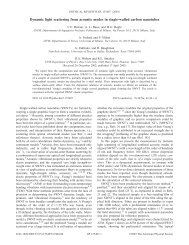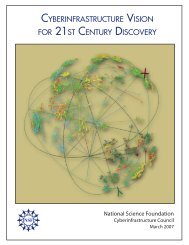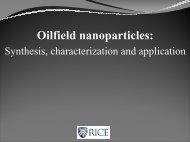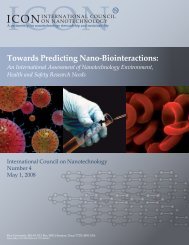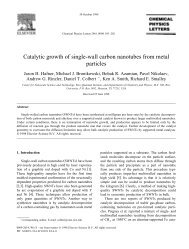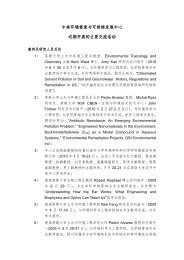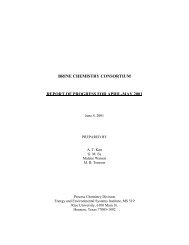Capillary Electrophoresis Separations of Bundled ... - Rice University
Capillary Electrophoresis Separations of Bundled ... - Rice University
Capillary Electrophoresis Separations of Bundled ... - Rice University
Create successful ePaper yourself
Turn your PDF publications into a flip-book with our unique Google optimized e-Paper software.
6066 J. Phys. Chem. B, Vol. 107, No. 25, 2003 Doorn et al.<br />
Figure 4. (a) Electropherogram <strong>of</strong> SDS-suspended nanotubes, monitoring<br />
the 1591 cm -1 intensity. (b) Electropherogram showing expansion<br />
<strong>of</strong> the y-axis. (c) Electropherogram monitoring the intensity ratio <strong>of</strong><br />
the 267 cm -1 to 234 cm -1 modes.<br />
identical to this spikesthe observed frequencies and relative<br />
intensities remain the same. In the second electropherogram<br />
region (500-677 s), the spike spectra also display the same<br />
frequencies and relative intensities as those that are observed<br />
in the first region. However, the background envelope now shifts<br />
to spectra that are dominant in the 234 cm -1 mode, with its<br />
intensity being approximately twice that <strong>of</strong> the 267 cm -1 band.<br />
The spectrum taken at 633 s (Figure 5c) is representative <strong>of</strong><br />
this second region. A further dramatic shift in the relative<br />
intensities is seen when one goes into the third region. Almost<br />
all the RBM intensity is now in the 234 cm -1 mode, plus two<br />
shoulders located at 226 and 215 cm -1 (Figure 5d). Spectra in<br />
this region are also similar to those observed in the fraction at<br />
1404 s in the PVP separations (Figure 3b), although with lower<br />
intensity observed in the 267 cm -1 mode. Low-intensity spikes<br />
are also observed in this third region. Spectra for these spikes<br />
are quite different than those found for the strong spikes in the<br />
first region. Rather than being dominant in the 267 cm -1 mode,<br />
the spectra are quite similar to the envelope spectra observed<br />
in the second region (Figure 5c), with the 234 cm -1 band being<br />
approximately twice the intensity <strong>of</strong> that at 267 cm -1 .<br />
Discussion<br />
The variations in the RBM intensities indicate that there are<br />
diameter-dependent spectral changes occurring over the course<br />
<strong>of</strong> a separation. It is tempting to relate these intensity changes<br />
directly to changes in the relative population <strong>of</strong> the corresponding<br />
diameter tube. However, there are several complicating<br />
Figure 5. (a) Radial breathing mode (RBM) Raman spectrum <strong>of</strong> bulk<br />
unseparated SDS-suspended nanotubes. Selected Raman spectra from<br />
separation shown in Figure 4 are also presented: (b) spectrum at 482<br />
s, (c) spectrum at 633 s, and (d) spectrum at 918 s.<br />
factors. The PVP samples used in this investigation are known<br />
to be bundles that vary in size and composition. Thus, the<br />
behavior observed is not that for separations <strong>of</strong> isolated,<br />
individual nanotubes. Furthermore, Raman spectra for nanotubes<br />
display strongly diameter-dependent resonance enhancement<br />
effects. Spectra for nanotubes <strong>of</strong> differing diameter will be<br />
enhanced to varying degrees for a fixed excitation wavelength.<br />
This is an important consideration for both the PVP and SDS<br />
systems. Only RBMs for nanotubes with a van Hove singularity<br />
near the 785 nm excitation energy will be significantly enhanced.<br />
These enhancement effects will be further perturbed in the<br />
PVP samples, because <strong>of</strong> the strong interaction expected among<br />
nanotubes in a given bundle. Bundling (roping) <strong>of</strong> the nanotubes<br />
gives rise to an orthogonal energy dispersion to the onedimensional<br />
density <strong>of</strong> states found in individual nanotubes,<br />
resulting in a change in energy spacing <strong>of</strong> the van Hove<br />
singularities. 18,19 For semiconducting nanotubes, the absorption<br />
maxima are broadened and shifted to lower energy. 19,20 This is<br />
a particularly strong effect for the 267 cm -1 mode, which can<br />
be used as an indicator <strong>of</strong> the degree <strong>of</strong> roping. For sufficiently<br />
large bundles, the electronic resonance for this mode strongly<br />
overlaps the 785 nm excitation energy. As the bundle size<br />
decreases, the resonance energy shifts to shorter wavelengths.<br />
This shift will result in a decrease in resonance Raman intensity<br />
at 267 cm -1 to a minimum when overlap is minimized between<br />
the 785 nm excitation energy and the electronic resonance for






